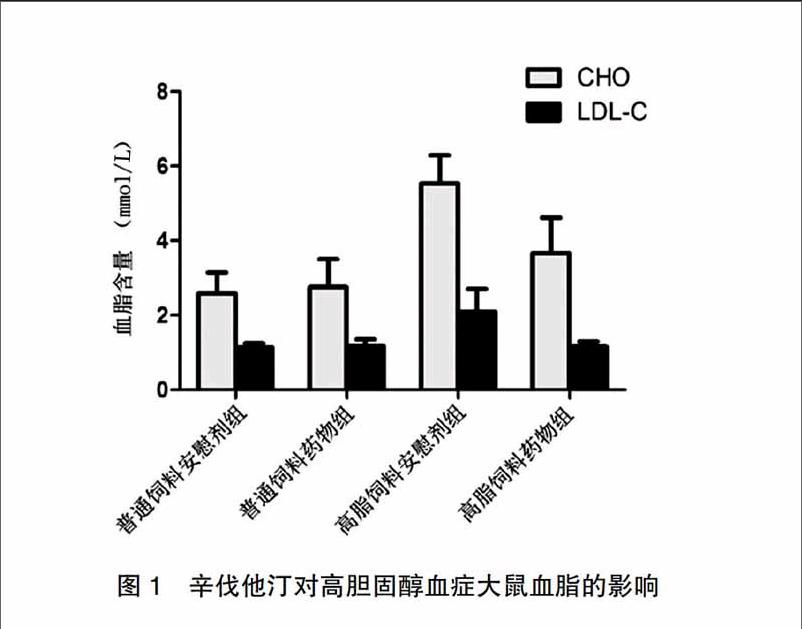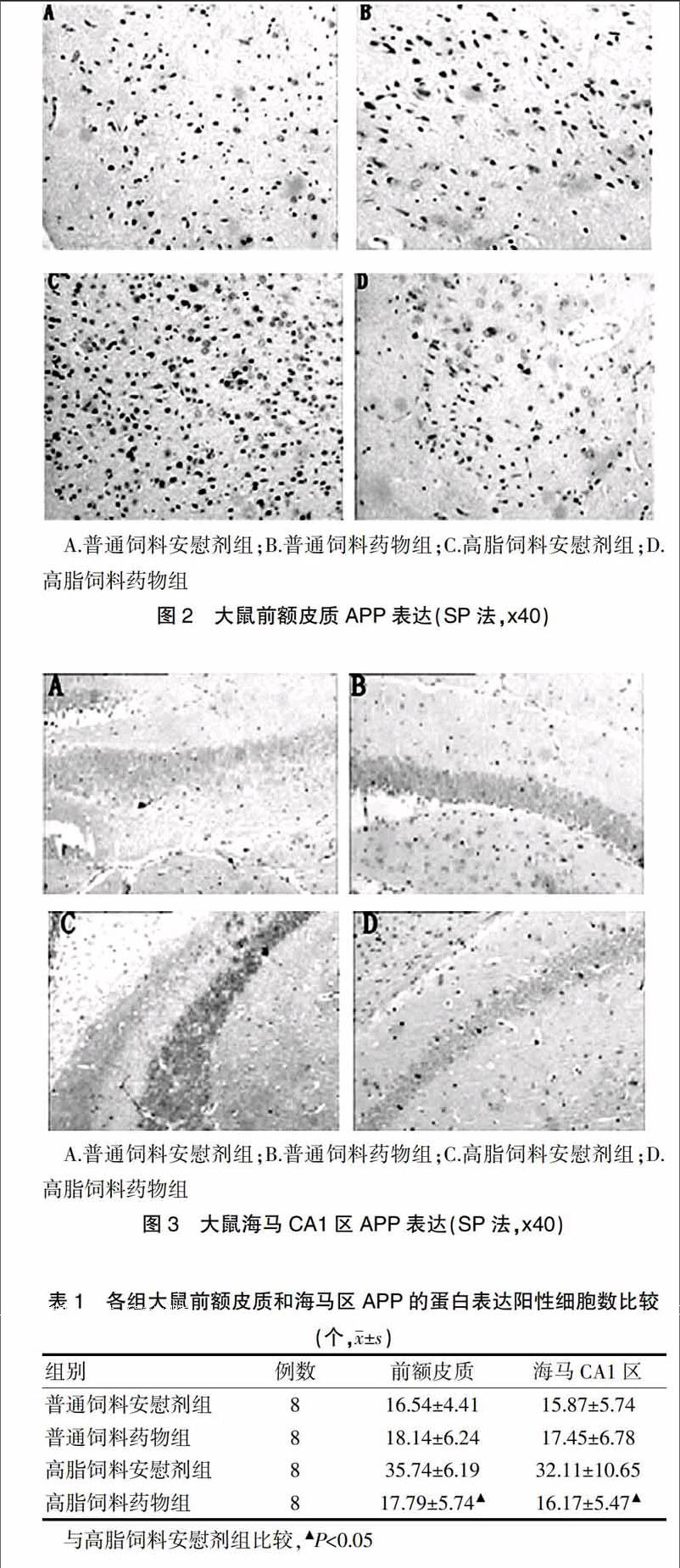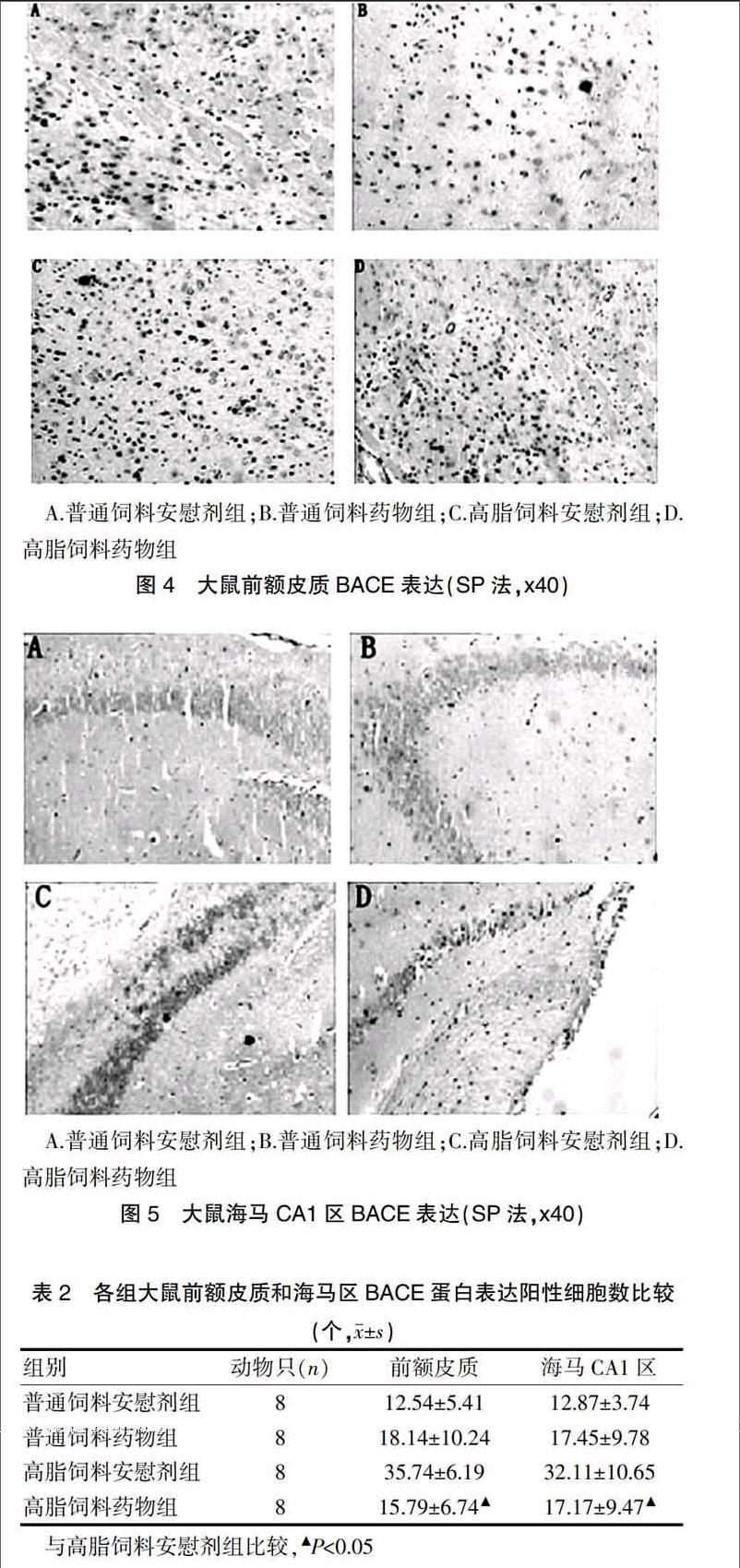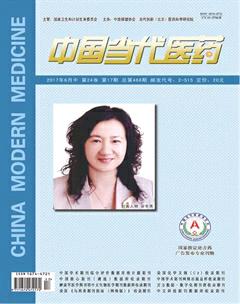辛伐他汀对高胆固醇血症大鼠APP、BACE蛋白表达的影响
梁倩++唐伟++刘文博++王威



[摘要]目的 探讨辛伐他汀对高胆固醇血症大鼠β-淀粉样前体蛋白(APP)、β分泌酶(BACE)蛋白表达的影响,为阿尔茨海默病(AD)的预防与治疗提供理论依据。方法 32只大鼠(3月龄)随机分为普通饲料喂养组(n=16)和高胆固醇饲料喂养组(n=16)。将高脂饲料喂养鼠随机分为高脂饲料安慰剂组(n=8)、高脂饲料药物组(n=8),并开始灌胃给药,高脂饲料药物组给予辛伐他汀2 mg/(kg·d)灌胃,高脂饲料安慰剂组给同体积安慰剂(蒸馏水)灌胃,灌胃期间继续喂高脂饲料。普通饲料喂养组随机分为普通饲料安慰剂组(n=8)和普通饲料药物组(n=8),分别给予同体积安慰剂(蒸馏水)和辛伐他汀2 mg/(kg·d)灌胃,灌胃期间继续喂普通饲料。8周后APP、BACE蛋白的表达。结果 高脂饲料药物组大鼠前额皮层、海马区APP、BACE的蛋白表达较高脂饲料安慰剂组减少(P<0.05),高脂饲料药物组与普通饲料安慰剂组、普通饲料药物组之间无显著性差异(P>0.05)。结论 辛伐他汀可能会影响高胆固醇血症大鼠前额皮层、海马区APP、BACE的蛋白表达,从而对Aβ1-42的生成代谢产生影响。
[关键词]辛伐他汀;高胆固醇血症;海马;皮层;β-淀粉样前体蛋白;β分泌酶;阿尔茨海默病
[中图分类号] R749.1 [文献标识码] A [文章编号] 1674-4721(2017)06(b)-0008-05
[Abstract]Objective To explore the efficacy of Simvastatin on the expression of APP and BACE in rats with hypercholesterolemia,providing theoretical basis for the prevention and treatment in Alzheimer′s Disease.Methods The 32 rats used in this experiment were 3 months old and randomly divided into normal diet group (n=16) and high cholesterol diet groups (n=16).The high diet groups were randomly divided into high lipid feed the placebo group (n=8) and high-fat feed drug group (n=8).And then medicine was filled into their stomach:the high fat diet drugs group were given simvastatin 2 mg/(kg·d),the high fat diet placebo group placebo (distilled water) by the same volume,the high fat forage during lavage.Normal feed group were randomly divided into normal feed placebo group and normal feed drug group,respectively to the same volume with the placebo (distilled water) and simvastatin 2 mg/(kg·d) to fill the stomach,the normal fat forage during lavage,with behavior evaluation after 8 weeks.Immune histochemical method to determine the brain′s protein expression with APP,BACE.Results The result of APP,BACE protein expression in the prefrontal cortex and the hippocampus with immunohistochemical detection:the protein expression of APP and BACE in the prefrontal cortexis and the hippocampus was decreased in high fat feed drug group than the normal feed placebo group (P<0.05),there was no significant difference in the normal feed placebo group,the normal feed drug group and the high fat feed drug group (P>0.05).Conclusion Simvastatin may affect the protein expression of APP,BACE in the prefrontal cortex and the hippocampus by the hypercholesterolemia rats,which have an impact on the metabolism of Aβ1-42.
[Key words]Simvastatin;Hypercholesterolemia;The hippocampus;Cortex;APP;BACE;Alzheimer′s Disease
阿爾茨海默病(AD)是多发于老年人的神经系统变性疾病,临床以进行性记忆、认知障碍及行为异常为特征[1]。随着社会老龄化迅速发展,AD的发病率急剧上升,严重影响老人的生活质量,并给家庭和社会带来沉重的经济负担。由于AD的病因复杂,临床治疗效果并不理想,对其发病机制的研究是防治AD发生发展的重要手段[2-3]。流行病学调查发现高血脂与AD发生相关[4-5]。动物实验显示β淀粉样蛋白(Aβ)的形成或降解与血中脂类代谢紊乱相关[6]。为此,降脂治疗能否调控Aβ形成,能否减缓AD发生发展等问题成为当前关注的热点。β分泌酶(BACE)是β-分泌酶的一种,是生成Aβ所必须的酶[7-8]。它能在体内作用于淀粉样前体蛋白(amyloid precursor protein,APP),是Aβ产生的初始酶,也是限速酶,被认为是防治AD的主要药物靶点[9]。本研究通过给予高脂血症大鼠辛伐他汀治疗,观察BACE及APP蛋白表达的变化,初步说明辛伐他汀对AD的治疗作用及其机制,现报道如下。
1材料与方法
1.1实验动物
Wistar大鼠(160~180 g),3月龄,SPF级,由大连医科大学实验动物中心提供,许可证号:SCXK2015-0002,经实验动物伦理委员会批准,并进行保种、繁衍后代,饲料营养充足,饮用无菌水,无菌处理2次/周,鼠笼为小刨花木材垫料笼,温度20~25℃,湿度50%~60%。高胆固醇饲料由北京华阜康生物科技股份有限公司提供,高胆固醇饲料由普通鼠饲料88.7%、胆固醇1%、猪油10%和胆酸钠0.3%组成。辛伐他汀片(舒降之,20 mg)由杭州默沙东制药有限公司提供,国药准字H19990366。
1.2动物模型的建立及分组给药
所用动物为32只大鼠,空腹12 h后取尾血,测定建模前血脂水平,然后随机分为普通饲料喂养组和高胆固醇饲料喂养组,每组16只,喂养2周后测定血脂水平,血脂明显升高且与普通饲料喂养组比较差异有显著性时,认为造模成功,再次分组,将高脂饲料喂养大鼠随机分为高脂饲料安慰剂组、高脂饲料药物组,每组8只,高脂饲料药物组给予辛伐他汀2 mg/(kg·d)灌胃,高脂饲料安慰剂组给同体积安慰剂(蒸馏水)灌胃,灌胃期间继续喂高脂饲料。将普通饲料喂养大鼠随机分为普通饲料安慰剂组、普通饲料药物组,每组8只,普通饲料药物组给予辛伐他汀2 mg/(kg·d)灌胃,普通饲料安慰剂组给同体积安慰剂(蒸馏水)灌胃,灌胃期间继续喂普通饲料。8周后再取尾血,测定血清胆固醇和低密度脂蛋白胆固醇,并取材。
1.3取材
每组8只大鼠用4%水合氯醛以10 ml/kg的剂量腹腔注射麻醉后开胸,充分暴露心脏,将针头插入左心室找至主动脉,剪开右心耳,用100 ml生理盐水灌流,直至流出的液体透明清澈无血液,然后用120 ml 4%多聚甲醛灌流固定,直至大鼠四肢及尾部僵硬为灌流固定充分,然后开颅、取脑,取出脑组织放置于4%多聚甲醛中固定,用于免疫组化标本制备。
1.4免疫组化检测小鼠APP、BACE表达水平
石蜡切片置60℃烤箱烘烤2 h;常规脱蜡至水,蒸馏水洗2 min;微波修复抗原20 min;3% H2O2溶液阻断过氧化物酶,10 min;PBS洗10 min×3次;滴加Aβ1-42(1∶100),4℃过夜;于冰箱中取出切片后室温静止20 min,PBS洗10 min×3次;加二抗,37℃孵育50 min,PBS洗10 min×3次;DAB显色2~3 min;复染、透明后封片,显微镜观察。
1.5统计学方法
采用SPSS 17.0统计学软件进行数据分析,计量资料数据用均数±标准差(x±s)表示,多样本均数比较采用多因素方差分析,组间两两比较采用LSD-t检验;以P<0.05为差异有统计学意义。
2结果
2.1辛伐他汀对高胆固醇血症大鼠血脂的影响
共纳入Wistar大鼠32只,所有大鼠均正常成功发育,进入结果分析,各组小鼠喂养共10周后,通过检测血清胆固醇提示:高脂饲料安慰剂组大鼠血清胆固醇(CHO)、低密度脂蛋白胆固醇(LDL-C)较高脂饲料药物組大鼠明显升高(P<0.05),辛伐他汀能明显降低血清CHO和LDL-C水平。普通饲料安慰剂组、普通饲料药物组和高脂饲料药物组三者间无显著差异(P>0.05)(图1)。
2.2各组大鼠前额皮质和海马区APP的蛋白表达结果
免疫组化结果如图2所示,APP蛋白主要表达于细胞胞浆、细胞突起和神经纤维。计数APP表达阳性细胞数结果提示,高脂饲料药物组大鼠前额皮层、海马区APP的蛋白表达较高脂饲料安慰剂组减少(P<0.05),高脂饲料药物组与普通饲料安慰剂组、普通饲料药物组之间无显著性差异(P>0.05)(图2、3,表1)。
2.3各组大鼠前额皮质和海马区BACE的蛋白表达结果
从免疫组化结果可以看出,BACE蛋白着色部位主要位于在胞浆、细胞突起和神经纤维,与APP蛋白定位较为一致(图3)。计数BACE表达阳性细胞数结果提示,高脂饲料药物组大鼠前额皮层、海马区BACE的蛋白表达较高脂饲料安慰剂组减少(P<0.05),高脂饲料药物组与普通饲料安慰剂组、普通饲料药物组之间无显著性差异(P>0.05)(图4、5,表2)。
3讨论
老年斑是AD脑内特征性的变化,是确诊AD的重要依据[10]。Aβ是老年斑的主要成分[11]。有学者认为AD是一个渐进性的过程,这一过程中伴随神经功能退化,同时研究还指出Aβ 的异常聚集事AD病理过程的起始因素,发生在AD病理过程的早期[12]。随着病情的进展,Aβ沉积过程伴随神经毒性物质的积聚并能触发一系列级联变化,进而促进AD病理过程的发展。随着对AD认识的深入,人们发现APP蛋白与Aβ生成密切相关[13]。
APP是一种跨膜蛋白质,由一条较长的细胞外N端节段与一条较短的细胞内C端节段组成,在不同的分泌酶作用下,APP裂解成不同的多肽产物,生理条件下这些多肽产物可以被细胞清除,在病理条件下Aβ生成增多,且清除不完全,逐渐沉积最终形成老年斑[14]。随着生活水平的提高,高脂饮食成为了老年斑形成的重要因素,也因此成为了人们研究AD发病的热点[15]。有研究报道胆固醇增多能够加强BACE的活性,从而增强APPβ裂解途径的作用,导致Aβ 1-40与Aβ 1-42多肽生成增多,造成Aβ沉积[16]。参与APP切割的关键酶(α、β、γ分泌酶)因其疏水性而必须在一个富含脂肪的环境中才具有生物活性,膜区的脂筏为APP和分泌酶提供了一个活性平台。在高胆固醇含量的脂筏环境中,APP更倾向于产生Aβ的代谢途径:BACE活性显著提高,β位点的切割增加,Aβ生产增多,从而形成大量老年斑,而在低胆固醇含量的脂筏环境中,APP更倾向于不产生Aβ的代谢途径:α分泌酶活性提高,Aβ产生减少[17-18]。
为了进一步探讨控制高脂能否影响APP、BACE的表达,本研究首先通过给予大鼠高脂饮食构建高胆固醇大鼠,通过检测大鼠血清胆固醇,低密度脂蛋白胆固醇含量提示高脂饮食成功构建高胆固醇大鼠模型。近年大量研究均证实了他汀药物在大鼠AD模型上对脑Aβ沉积物的作用,结果显示阿托伐汀可以显著减弱Aβ在动物模型中的沉积[19-20]。那么,辛伐他汀有效改善高胆固醇血症大鼠的Aβ1-42是通过何种机制实现,是否与APP、BACE有关?本研究通过免疫组化方法检测大鼠前额皮层、海马区APP蛋白与BACE蛋白的表达,结果提示高脂饲料药物组大鼠前额皮层、海马区APP、BACE的蛋白表达较高脂饲料安慰剂组表达明显减少,二者之间比较差异明显,具有统计学意义(P<0.05),说明辛伐他汀能够降低脑内APP、BACE的蛋白表达有关。本研究结果提示辛伐他汀可能通过抑制前额皮质与海马区的APP及BACE蛋白的表达,进而影响Aβ1-42的表达来影响高脂血症大鼠向AD的发展。
综上所述,本研究结果提示了辛伐他汀能够有效控制高脂血癥,同时能够抑制Aβ1-42调控因子APP与BACE蛋白的表达,这一作用机制提示辛伐他汀可能作为今后控制AD进展的潜在治疗药物。由于本实验尚存在不足,进一步证实辛伐他汀的治疗AD的作用及其深入的机制尚需要更多的实验来证实。
[参考文献]
[1]Mary Ann A DeMichele-Sweet Ph D,Robert A.Genetics of psychosis in Alzheimer disease[J].Curr Genet Med Rep,2014, 2(1):30-38.
[2]Cervellati C,Wood PL,Romani A,et al.Oxidative challenge in Alzheimer′s disease:state of knowledge and future needs [J].Amer Fed Clin Res,2016,64(1):21-32.
[3]Simic G,Babic Leko M,Wray S,et al.Tau Protein Hyperphosphorylation and Aggregation in Alzheimer′s Disease and Other Tauopathies,and Possible Neuroprotective Strategies[J].Biomolecules,2016,6(6):1-28.
[4]Ricciarelli R,Canepa E,Marengo B,et al.Cholesterol and Alzheimer′s disease:a still poorly understood correlation[J].IUBMB life,2012,12(64):931-935.
[5]Dias HK,Brown CL,Polidori MC,et al.LDL-lipids from patients with hypercholesterolaemia and Alzheimer′s disease are inflammatory to microvascular endothelial cells:mitigation by statin intervention[J].Clin Sci,2015,129(12):1195-1206.
[6]Kuo PH,Lin CI,Chen YH,et al.A high-cholesterol diet enriched with polyphenols from Oriental plums(Prunus salicina) improves cognitive function and lowers brain cholesterol levels and neurodegenerative-related protein expression in mice[J].Brit J Nutr,2015,113(10):1550-1557.
[7]Mamada N,Tanokashira D,Hosaka A,et al.Amyloid beta-protein oligomers upregulate the beta-secretase,BACE1,through a post-translational mechanism involving its altered subcellular distribution in neurons[J].Mol Brain,2015,11(8):73-77.
[8]Shimizu H,Tosaki A,Kaneko K,et al.Crystal structure of an active form of BACE1,an enzyme responsible for amyloid beta protein production[J].Mol Cell Biol,2008,28(11):3663-3671.
[9]Devi L,Ohno M.Effects of BACE1 haploinsufficiency on APP processing and Abeta concentrations in male and female 5XFAD Alzheimer mice at different disease stages[J].Neuroscience,2015,307(8):128-137.
[10]Ohno-Matsui K.Parallel findings in age-related macular degeneration and Alzheimer′s disease[J].Prog Retin Eye Res,2011,30(4):217.
[11]Parsons CG,Ruitenberg M,Freitag CE,et al.Rammes G.MRZ-99030-A novel modulator of Abeta aggregation:I-Mechanism of action(MoA) underlying the potential neuroprotective treatment of Alzheimer′s disease,glaucoma and age-related macular degeneration(AMD)[J].Neuropharmacol,2015,92(21):158-169.
[12]Iaccarino HF,Singer AC,Martorell AJ,et al.Gamma frequency entrainment attenuates amyloid load and modifies microgli[J].Nature,2016,540(32):230-235.
[13]Ourdev D,Foroutanpay BV,Wang Y,et al.The Effect of Aβ1-42 Oligomers on APP Processing and Aβ1-40 Generation in Cultured U-373 Astrocytes[J].Neuro-degenerative diseases,2015,15(6):361-368.
[14]Dobrowolska JA,Michener MS,Wu G,et al.CNS amyloid-beta,soluble APP-alpha and-beta kinetics during BACE inhibition[J].Neurosci,2014,34(24):8336-8346.
[15]Tang Y,Peng Y,Liu J,et al.Early inflammation-associated factors blunt sterol regulatory element-binding proteins-1-mediated lipogenesis in high-fat diet-fed APP/PSEN1dE9 mouse model of Alzheimer′s diseas[J].J Neurochem,2015, 136(4):791-803.
[16]Cui W,Sun Y,Wang Z,et al.Activation of liver X receptor decreases BACE1 expression and activity by reducing membrane cholesterol levels[J].Neurochem Res,2011,36(10):1910-1921.
[17]Savage MJ,Holder DJ,Wu G,et al.Soluble BACE-1 Activity and sAβPPβ Concentrations in Alzheimer′s Disease and Age-Matched Healthy Control Cerebrospinal Fluid from the Alzheimer′s Disease Neuroimaging Initiative-1 Baseline Cohort[J].JAD,2015,46(2):431-440.
[18]Stromberg K,Eketjall S,Georgievska B,et al.Combining an amyloid-beta(Abeta)cleaving enzyme inhibitor with a gamma-secretase modulator results in an additive reduction of Abeta production [J].The FEBS journal,2015,282(1):65-73.
[19]DeKosky ST.Statin therapy in the treatment of Alzheimer disease:what is the rationale?[J].Am J Med,2005,12(12):48-53.
[20]Li G,Larson EB,Sonnen JA,et al.Statin therapy is associated with reduced neuropathologic changes of Alzheimer disease[J].Neurology,2008,69(9):878-885.
(收稿日期:2017-03-29 本文編辑:马 越)

